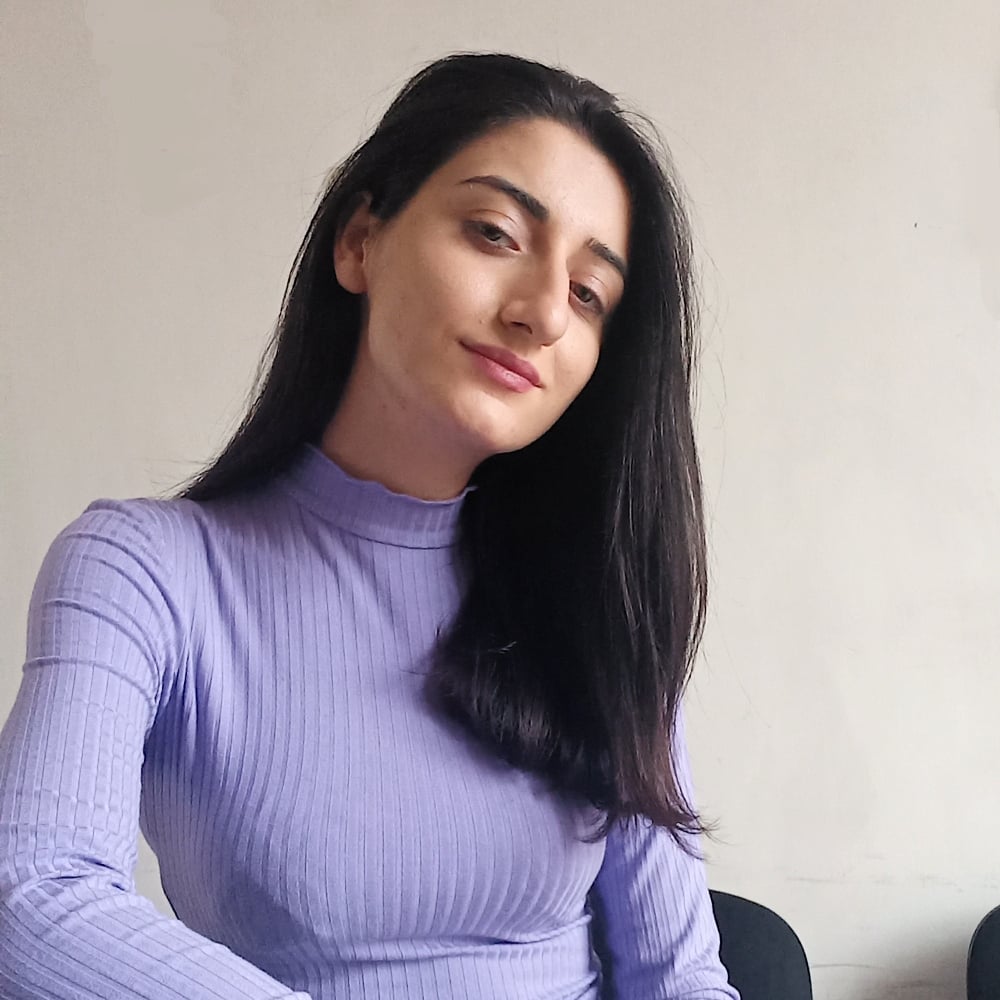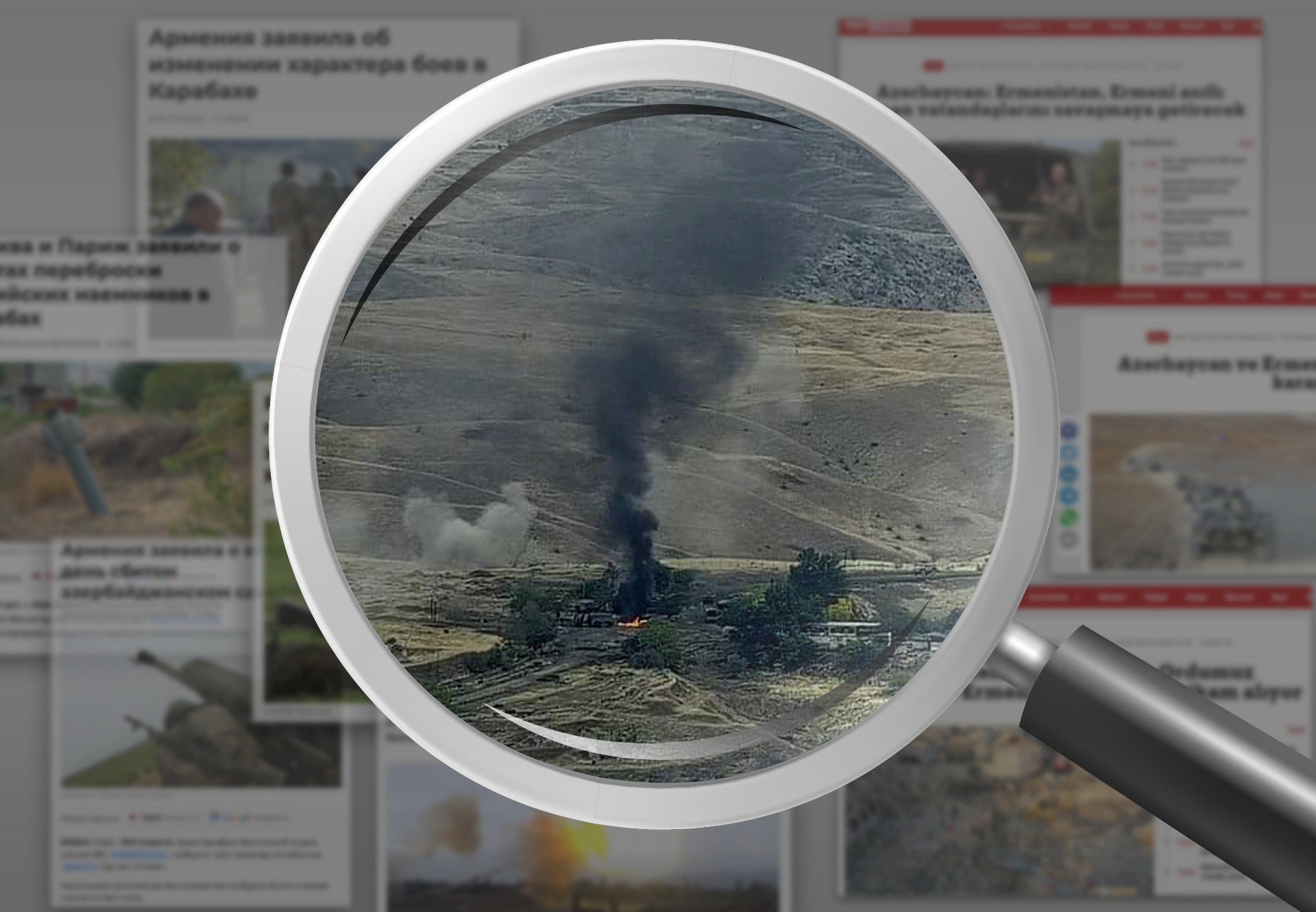The Media Initiatives Center (MIC) conducted research in 2020 studying the three main topics on the Armenian agenda of the same year: the coronavirus, the Artsakh issue and the Lanzarote Convention.
In this article, Media.am studied the information policy of the Russian and Turkish state media during the Second Artsakh War.
As in all wars, the state information of the direct participants in the conflict, Armenia and Azerbaijan, turned into propaganda, and the media was mainly subject to censorship. There was a wider field of study and opportunity in the case of two regional actors, the state media of Russia and Turkey.
The study of the information field of these countries was more important against the background of the 44-day war, as they now have a military presence in the conflict zone and control the ceasefire regime.
Thus, we have observed the coverage of the Russian and Turkish state media from the beginning of the war (September 27) to its end (November 9), subjecting it to quantitative and qualitative analysis.
Our goals were to find out what information policy was pursued by the state media of the two countries, with what emphasis they spoke about the second Artsakh war, we also highlighted the context under which the coverage was made.
If you do not have time to read: What did we find out?
- When writing about the 44-day war, RIA relied heavily on official Armenian information and the information of its correspondents working in Artsakh, which were largely pro-Armenian. Despite that, the media apparently remained neutral, also giving voice to the official messages of Azerbaijan. Coverage from the territory of Azerbaijan was small. Haber was dominated by official Baku messages and anti-Armenian content. Only 7 Armenian official messages appeared on Turkish news sites.
- Both media outlets pursued information policies in line with their countries’ official position on the issue. Both RIA and Haber published misinformation while covering the war. In this case, the Russian news site mostly acted as a transmitter of information, and not as a source of spreading false news. In the case of Haber, very often the source of the information was not mentioned, the news site was the first source to spread false news and manipulations.
- Although there was a significant difference in the transmission of official messages from Armenia and Azerbaijan in both media outlets, RIA gave more voice to Armenian sources and Haber for Azerbaijani sources, but both sites covered Ilham Aliyev more than Pashinyan. Even in the case of a few references, Haber wrote about Pashinyan in a negative context, even if it covered his visit to Artsakh. RIA also did not refrain from giving a negative context when talking about Pashinyan. The RA Prime Minister was particularly accused of organizing a color revolution and worsening relations with Russia.
- RIA framed the coverage of the Artsakh war, often giving an anti-Turkish context. A number of articles have been published in which, ostensibly maintaining neutrality towards the conflicting parties, Turkey is presented as an aggressor and incapable of resolving the conflict, and Russia as the only force capable of ending the conflict. Although there was no overtly anti-Russian content in Haber, the articles highlighted the context of the inefficiency of the Minsk Group (co-chaired by Russia).
- In almost all references, the Turkish media stressed that the war was provoked by the Armenian side. In any case, there was no coverage of pro-Armenian content. Instead, they talked about the involvement of Kurdish militants in the Armenian army, the unilateral violation of humanitarian rights by Armenia and the commission of a war crime.
- In RIA, the war was framed by various politicians and analysts as a process controlled by Russia. The misinformation that appeared here was from both Armenian and Azerbaijani sources.
РИА Новости (RIA)
There are two major state news agencies operating in Russia. The media outlet we are watching is РИА Новости (RIA Novosti). The study was conducted using the Rumors monitoring tool, from which, with the help of “keywords,” we separated the publications related to Artsakh and the Artsakh conflict within 44 days.
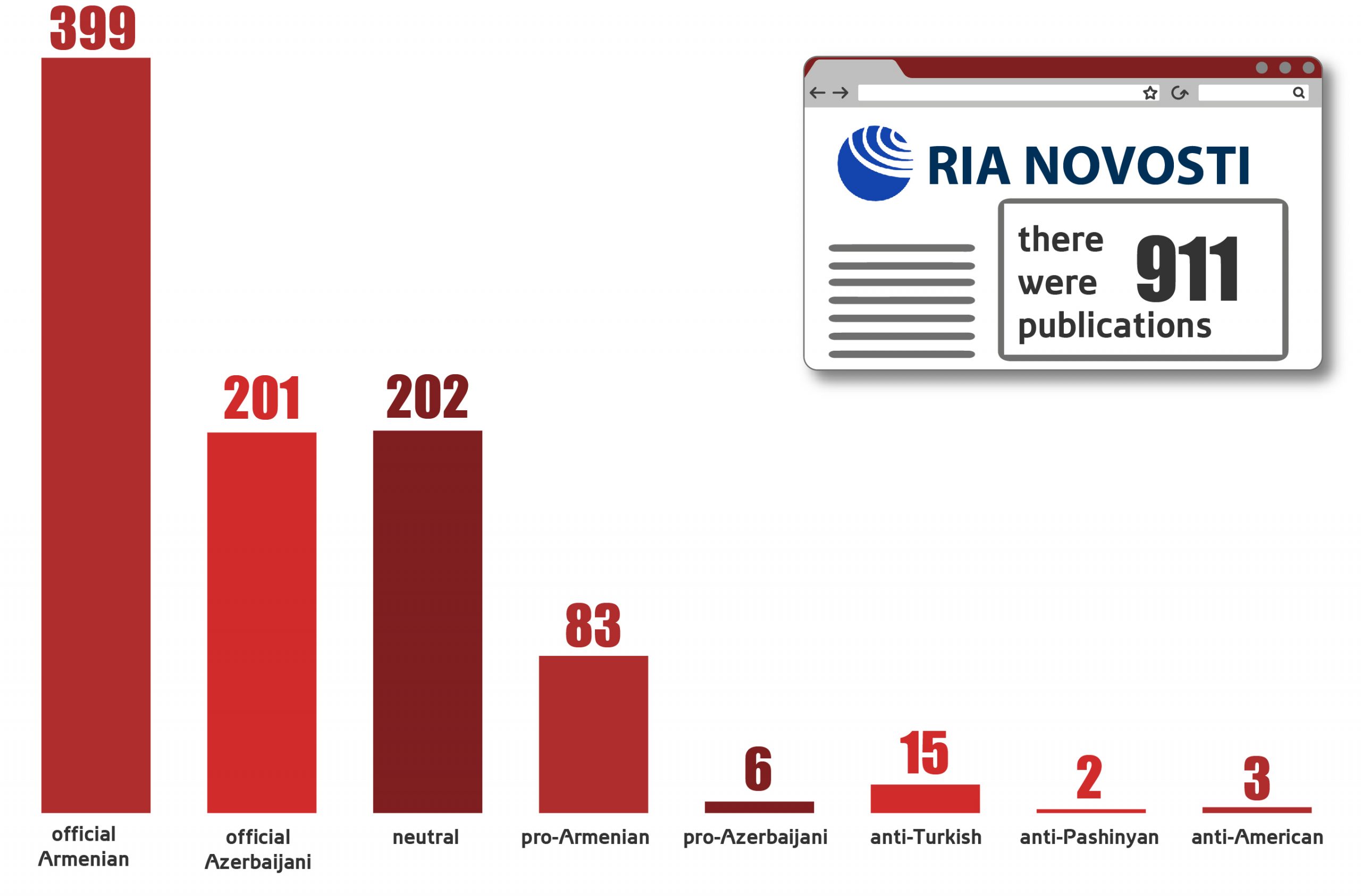
Thus, 911 posts related to the Armenian/Artsakh-Azerbaijani conflict were coded for the monitoring period. 43.6% of them are official statements of the Armenian side, which include the statements of both Armenian and Artsakh officials. In about 22% of cases, the Russian media published official statements from Azerbaijan, including excerpts from interviews with President Ilham Aliyev. Neutral publications make up 22% of the total. This includes materials in which the media outlet published the statements of current or former officials or experts of a third country.
9% of the materials had obviously pro-Armenian content. This list includes the publications when the journalist personally presented the situation from the Artsakh Republic. For example, they warned that the air signals in Stepanakert were turned on, presented the condition of the journalists injured as a result of the Azerbaijani shelling, and spoke about the militants brought by Azerbaijan to the conflict zone. We consider these publications pro-Armenian, as materials from Azerbaijan with the same operative nature did not appear in RIA. It is true that this coverage was mostly objective realities, but the intense coverage of the devastation on one side only gives the reader a one-sided approach to the conflicting parties.
Such materials from the Azerbaijani side were rare in RIA. There were 6 publications where the journalist personally covered the events from Azerbaijan or the territories under its influence or presented the situation of civilians in the hot stages of the conflict.
We have also considered 15 anti-Turkish materials, 5 of which seem to maintain neutrality towards the conflicting countries. For example, Russia’s permanent representative to the UN Vasily Nebenzya is quoted as saying that, unlike Ankara, Russia does not support any of the parties. In another case, the media outlet conveys the opinion of the leader of the Liberal Democratic Party Vladimir Zhirinovsky that only Russia can resolve the conflict between Azerbaijan and Armenia, and if Turkey intervenes, it will be bad for both Armenia and Azerbaijan.
We have singled out two more materials in which Nikol Pashinyan and his government are accused of weakening relations with Russia, appeasing the West and carrying out a “color revolution.” In general, the RA Prime Minister was referred to 85 times, and the President of Azerbaijan – 111 times.
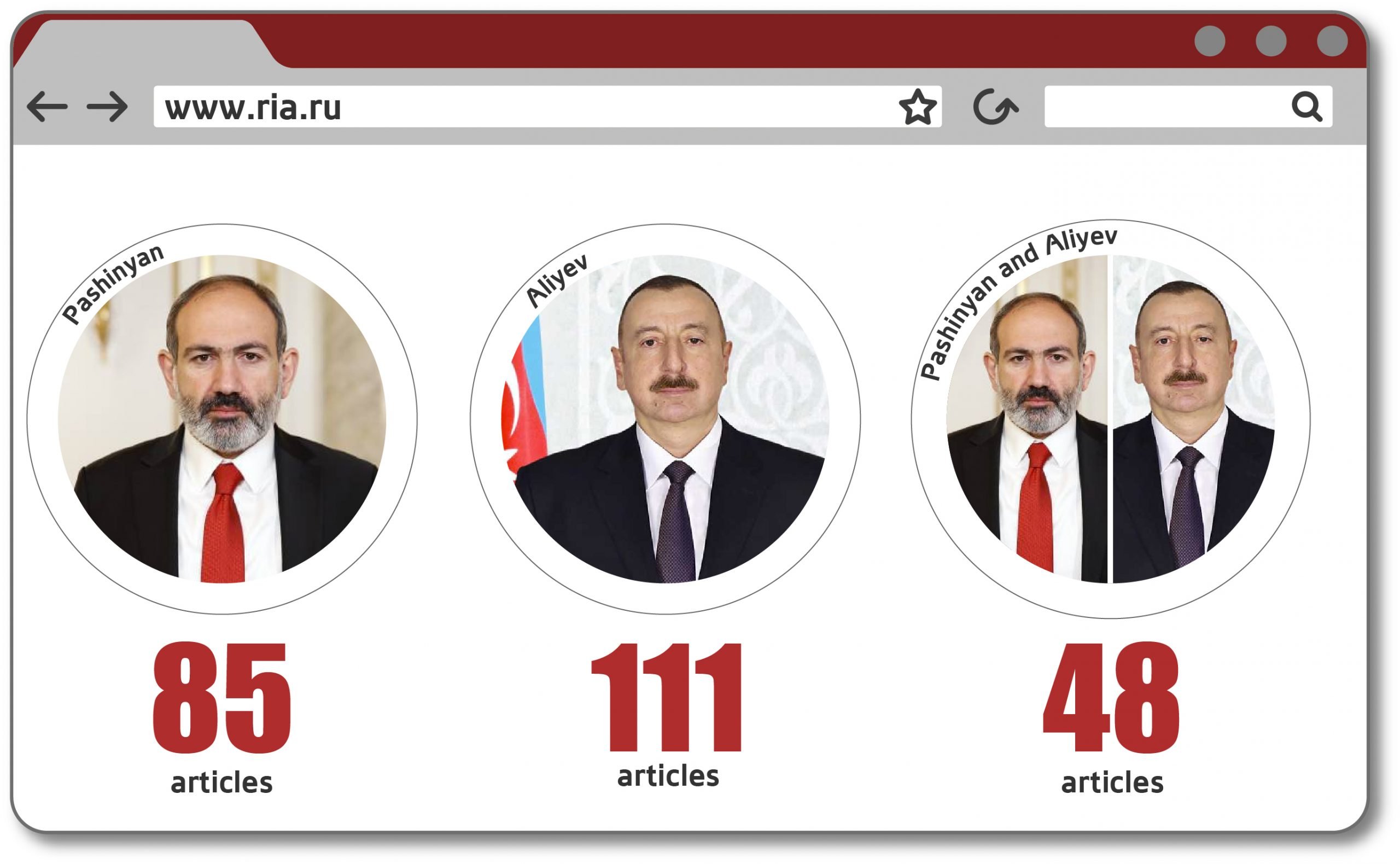
In the context of the Artsakh war, 3 anti-American materials were also considered, in which the United States is presented as a party unable to resolve conflicts, and the American McDonald’s as a company supporting Azerbaijan, as the Azerbaijani branch of the latter wrote on its official Instagram page, “Let our flag wave on all the native lands of Azerbaijan.” This post was later deleted.
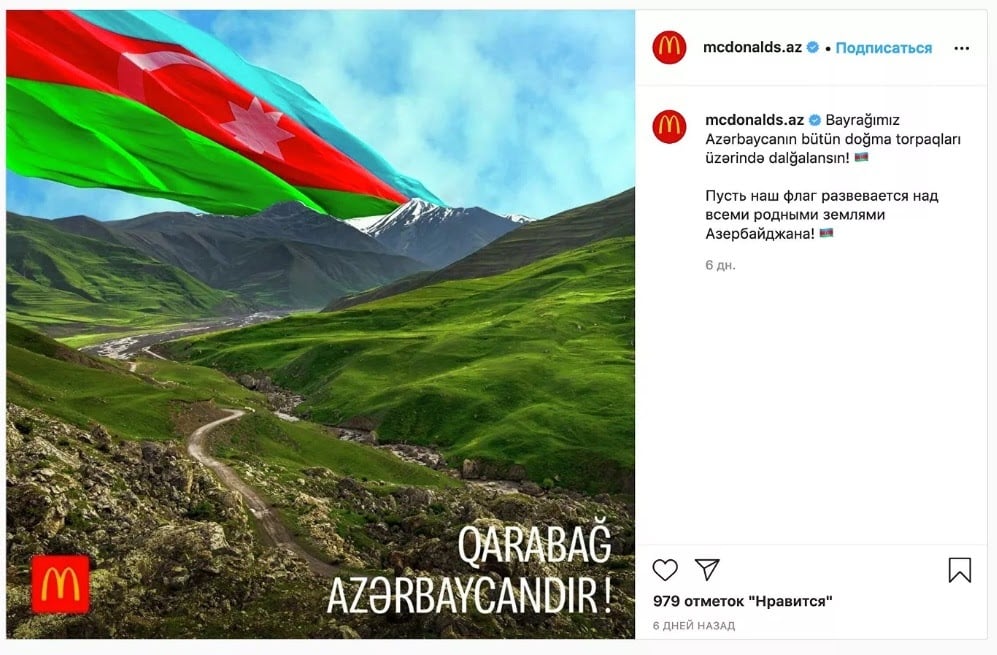
Propaganda theories in “RIA Novosti”
A. Will Russia not allow a war?
On September 29, the article of journalist and political commentator, Petr Akopov, was published. The author predicted that Russia would not allow a large-scale war between Armenia and Azerbaijan, giving different reasons for his claims. The article also appeared in the Armenian press on the website, irates.am.
This propaganda theory is not new: The same mentality has prevailed in Armenian society for years. We have also heard similar formulations from Prime Minister Nikol Pashinyan. After the second Artsakh war, we can say that for years we have been dealing with a myth that was promoted in both the Armenian and Russian media.
B․ Ganja Airport didn’t vanish after all
On October 4, RIA wrote about the destruction of the Azerbaijani Ganja military airport, citing a Facebook post by Artsakh President’s spokesman Vahram Poghosyan. The Ministry of Defense of Azerbaijan denied the news, and the Armenian side did not present any facts of the destruction of the military object.
With the help of satellite photos in late November, it became clear that the news about the destruction of Ganja airport was false. It had not changed before or after the war.

C․ Turkey’s involvement in the war
On October 4, RIA quoted official Baku as denying that the news of Turkey’s involvement in the hostilities pursued one goal: to involve a third party in the conflict. Thus, Azerbaijan denied the involvement of the Turkish side, including the presence of F-16 fighters.
In his interviews, Ilham Aliyev also ruled out Turkey’s direct participation in the ongoing operations in Nagorno-Karabakh.
There is a lot of evidence proving Turkey’s involvement. The “Stratfor” research center wrote about it. High-ranking officials from Russia, France and Iran have alerted about the Syrian mercenaries recruited by Turkey and transferred to Azerbaijan. Many authoritative media outlets have also written about it, such as CNN, BBC, The Washington Post, etc. Let’s also remember “New York Times” investigative journalist, Christian Tribert’s post, who proved the existence of two F-16 fighters at Ganja airport.
D․ The media “killed” the Artsakh President many times
On October 4, Hikmet Hajiyev announced during a briefing that Artsakh President Arayik Harutyunyan had been seriously injured. This news also appeared in RIA. The information was spread after Arayik Harutyunyan’s announcement to leave for the front line. The news about the President’s injury, as well as his death was widely spread on Azerbaijani websites.
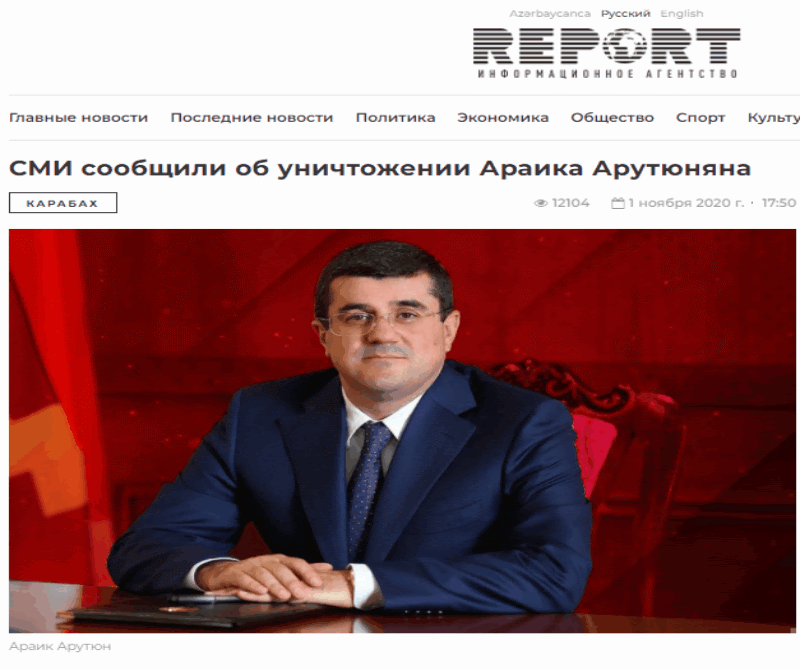
The information was false, there was an official denial about it. On November 4, photos had been published, later also video messages with the participation of Arayik Harutyunyan.
E․ Didn’t Azerbaijan target civilians?
At the end of October, the statement of the Ministry of Defense of Azerbaijan was published that they did not target the civilian population of Artsakh. Ilham Aliyev also mentioned this in an interview with “France 24.”
There is a lot of evidence to refute the information. Since the first day of the war, Stepanakert, with a population of 55,000, and numerous settlements in Artsakh have been subjected to widespread rocket fire and bombardment. The first victims were civilians. By the end of the war, 50 Armenian civilians had been killed and 148 wounded. In early October, Azerbaijan targeted the Shushi Palace of Culture, the Stepanakert power grid building, and electrical substations, causing power outages.
Azerbaijan has also targeted medical facilities. On October 28, airstrikes were carried out on the Stepanakert maternity hospital. About 673 Turkish and Israeli missiles and cluster munitions were found in the capital Stepanakert alone. Many residential buildings in the capital of Artsakh were damaged, schools and kindergartens were shelled. The war crimes committed by Azerbaijan are detailed in the EVNReport study.
TRT Haber
There are another two Turkish state agencies. We watched TRT Haber.com. 361 articles were coded for the monitoring period.
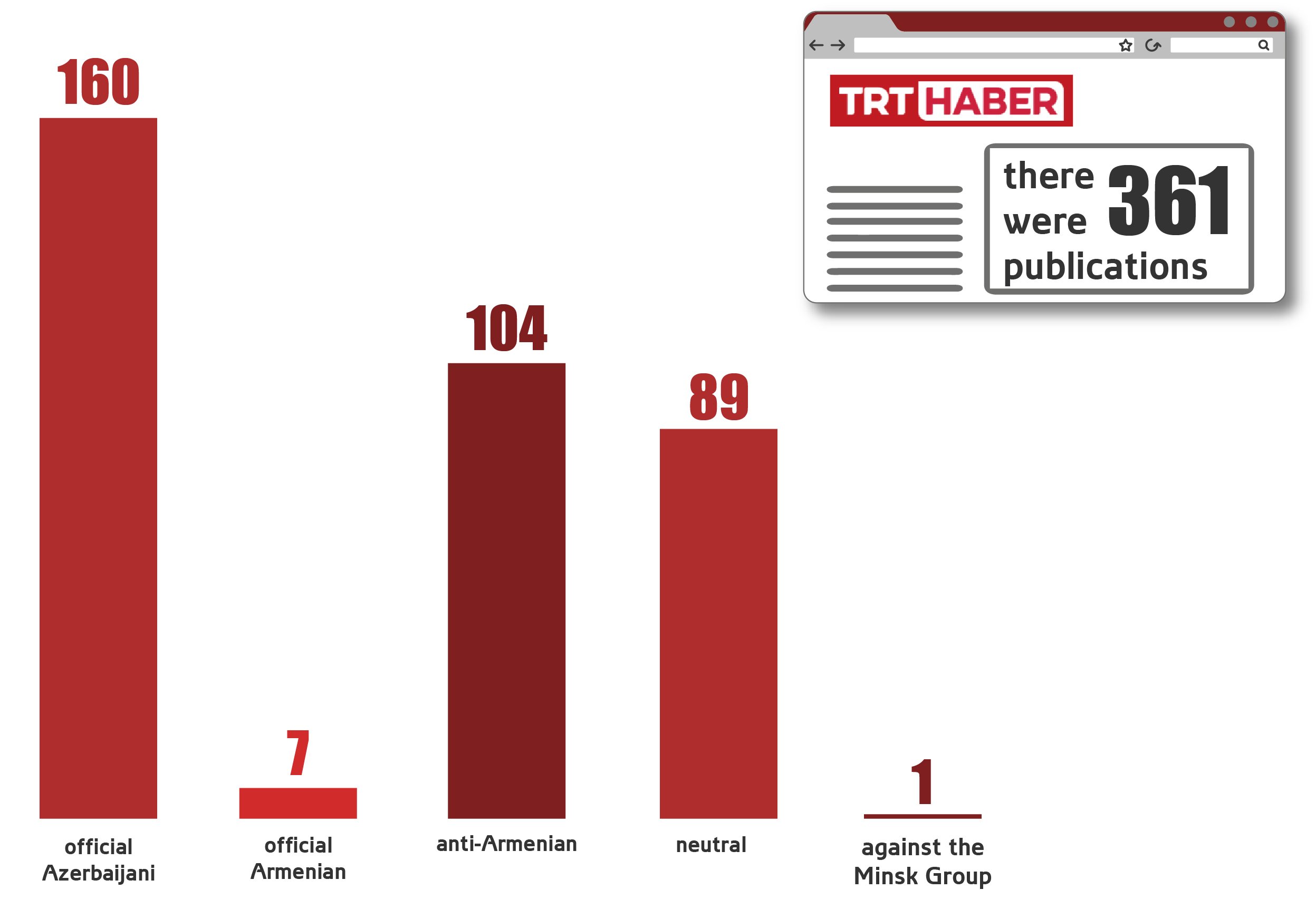
About 44.3% of the materials were devoted to official statements in Baku, including statements and interviews by President Ilham Aliyev. The official statements of the Armenian side made 1.9% of the total number, which also included the statements or visits of Prime Minister Pashinyan.
Even in these small publications, there are biased comments. For example, there is talk about Nikol Pashinyan’s visit to Artsakh, but it is titled, “Pashinyan is looking for a provocation. He visited the Karabakh front line.”

There were 104 materials (28.8%) containing anti-Armenian content, 10 of which were dedicated to the news of the involvement of the Kurdish Workers’ Party (PKK) in the Armenian Armed Forces.
We have conditionally singled out 89 examples of neutral publications (24.6%), when the ceasefires, the words of the officials of third countries, bilateral or trilateral meetings and other events were covered. Conditional, because even in this case there was a dynamic to quote the words of people who expressed a non-Armenian position. In no case were statements made in favor of Armenia. Armenians and Azerbaijanis protested in different countries of the world, but only Azerbaijanis were covered.
The articles consistently underlined the inefficiency of the Minsk Group. Despite that, one article was published, which was entirely dedicated to the history of the Minsk Group. It should be noted that most of the materials lacked a source of information.
Propaganda theories on TRT Haber
A. The party that unleashed the war was Armenia
From the beginning of the war, TRT Haber was full of materials, where Armenia was presented as the party that unleashed the conflict. Facts, however, speak of the opposite being true.
? On September 21, the Ministry of Defense of Azerbaijan issued a statement about a soldier killed by an Armenian bullet. This news spread in the Azerbaijani media with unprecedented speed, while the Azerbaijani press is usually silent about losses.
? During the war, the song and the video dedicated to the second Artsakh war were already ready.
? Since September 21, civilian vehicles have been recruited for military purposes.
? According to the BBC, an unannounced mobilization had begun.
? On September 26, FIP.am recorded an unusual activation of flights between Turkey, Azerbaijan and Israel.
? Hours after the fighting, some Turkish media outlets, such as the Turkish state television channel TRT and Anadolu, were already at the frontlines.
B․ The mythical presence of Kurdish militants in the Armenian army
TRT Haber, like other Turkish and Azerbaijani media outlets, actively wrote about the presence of foreign armed groups, particularly the Kurdish Workers’ Party (PKK) in the Armenian armed forces. These conversations started back in the 1990s. During the 44-day war and in the days that followed, this theory spread with new vigor.
- First, on September 24, the Azerbaijani media began to write that the Armenian battalion formed in the north of Syria was sent to Artsakh to take part in the battles against Azerbaijan. No evidence of what was said was presented, instead false and unsubstantiated allegations were made.
Azerbaijani media outlets published an article entitled “Syrian terrorists as part of the Armenian occupation forces.” Day.az stressed that there are officers of the Armenian Armed Forces with the Syrian terrorists. The attached photos were actually taken in Syria in 2019, during the gathering of the “Armenian Brigade after Nubar Ozanyan,” which took place on the anniversary of the Armenian Genocide.

- Derindusunce.org posted a photo of Serbian actor and producer Miloš Biković on his Twitter microblog with the caption…
Kosovo war veteran Aleksa Djuric, now a Russian PMC, has been spotted in Armenia.His fate is not yet certain https://t.co/gJ88zRN2sC pic.twitter.com/wZsDRwSoTS
— ZOKA (@200_zoka) September 28, 2020
In fact, this photo was taken from the shooting site of the movie “Kosare,” which was used to involve the actor in the controversy. Biković personally responded to the news.
- Günaz TV and Sepahcybery Telegram channels and various Azerbaijani media outlets published a video with the participation of the military, again noting that Armenia has involved PKK terrorist militants in the fighting. As proof, the video of the volunteer detachment of the Yezidi community of Armenia was attached, where both Armenian and Yezidi flags can be seen. Moreover, the same video was also posted on the Yezidi Pers tna Instagram page. The words that were spoken in Yezidi mean “Who are we, the Yezidis?”
In another case, the Turkish service of CNN, CNN TÜRK, prepared an 8-minute material about the PKK militants “fighting” in Artsakh. During the report, the footage was published to show that PKK militants were fighting in Artsakh together with “ASALA.”
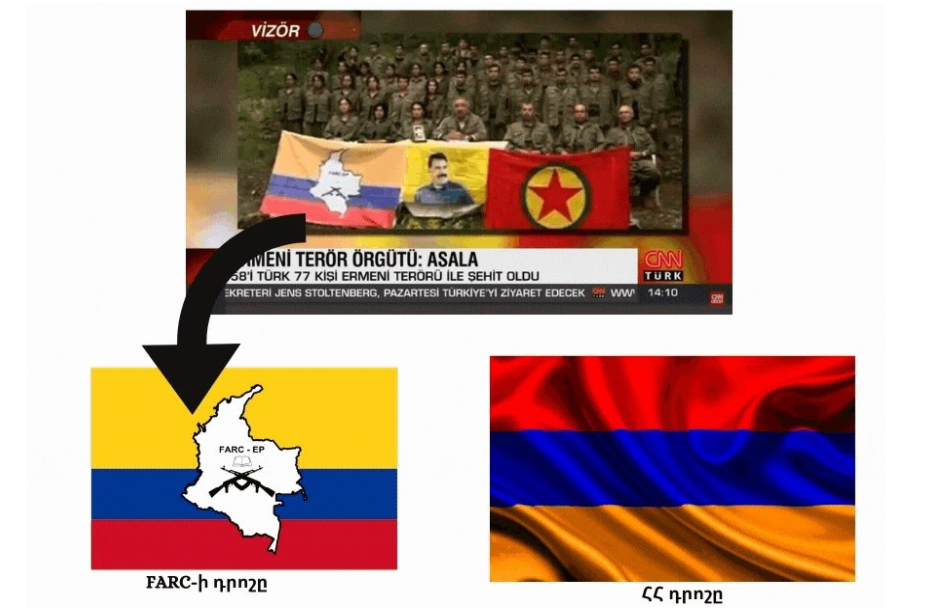
In fact, the news outlet confused the flag of the Colombian National Army (FARC) with the tricolor of the Republic of Armenia. The displayed photo was taken in 2014.
C․ International humanitarian law has been violated bilaterally
On October 22, TRT Haber wrote about the banned weapons used against the civilian population of Azerbaijan. This assertion was later confirmed by Amnesty International and Human Rights Watch.
During a visit to Azerbaijan in November, Human Rights Watch researchers identified four cases of cluster munitions in three regions (Tartar, Barda, and Geremboy). As a result, at least 7 citizens were killed and about 20 people were injured.
The problem is that the media did not cover the cluster bombs used by Azerbaijan in the past, which were reported to Amnesty International on October 5. During the investigation conducted in Artsakh in October 2020, Human Rights Watch also documented cases of the use of cluster munitions by Azerbaijan. According to a report published by Amnesty International on January 13, 52 civilians were killed in the war between September 27 and November 10. This once again proves that the Turkish media has a selective attitude to the facts.
The UN Convention on the Use of Cluster Weapons was agreed in 2008 in Dublin. To date, more than 100 countries have joined the document, but neither Armenia nor Azerbaijan has signed a convention banning the use of cluster munitions.
Summing up the study of the topical articles of the two Turkish and Russian state media, it should be noted that during the 44 days of the Second Artsakh War, TRT Haber and RIA Novosti did not provide balanced coverage. Both media outlets in one way or another supported the reproduction of the information policy of one of the parties to the conflict, and sometimes also the dissemination of misinformation. However, in the case of RIA, the position was expressed indirectly, in the case of Haber, it was done openly.
Ophelia Simonyan
